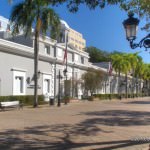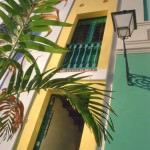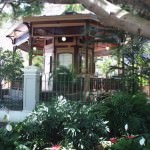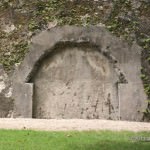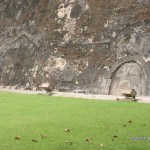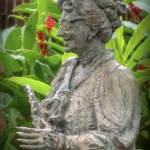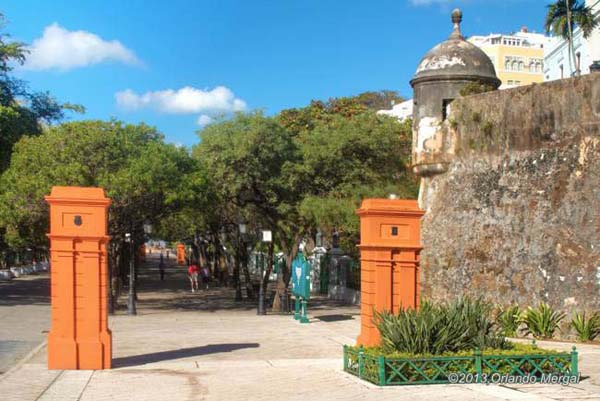
“La Princesa” Promenade, or “Paseo de la Princesa” as the locals call it, is a beautiful walkway that starts west of the Banco Popular building and ends next to San Juan Bay with the beautiful “Raíces” fountain.
The “Paseo de la Princesa” has existed since colonial times but the one that you see today was rebuilt in 1992 to commemorate the 500th anniversary of the discovery of America. The event was highlighted by the Columbus Regatta, which brought the world’s largest tall ships to the port of San Juan.
Many of the city’s buildings, monuments and squares were refurbished or rebuilt for that occasion.
As you walk down “Paseo de la Princesa” you will be bordering the city wall. Construction of the San Juan city walls started in 1634. By 1650 the walls protected the north, west and south sides of the city, while a half-built fort “San Cristóbal” protected the eastern side from land attacks.
The walls average a height of 42 feet. Thickness goes from 18 feet at the top to 40 feet at the bottom. They are made of solid sandstone blocks, held together with mortar, limestone sand and water. However, in order to resist the impact of a 24-pound canon ball traveling at high velocity, the walls were constructed following a “sandwich” design, where the exterior and interior layers of the wall are made of solid sandstone, and the center is filled with impact absorbing rubblework. If a canon ball managed to pierce the outer layer, the energy-absorbing core would stop the projectile.
You will also notice that the promenade is lined with gardens and statues along the base of the city walls. One particularly interesting statue is dedicated to Felisa Rincón de Gautier, better known as “Doña Fela” who was the first woman to hold the office of mayor of an important city in the western hemisphere, and served for a period of 22 years from 1946 to 1968.
Doña Fela is best remembered by the “Sanjuaneros” for bringing a planeload of snow for the city’s disadvantaged children to play in during Christmas season. But her many achievements earned her awards, commendations and degrees from most of the world’s leading countries. In 1954 she was awarded the distinction of “Woman of the Americas” by the Union of American Women of New York for her many contributions to the Western Hemisphere. The statue depicts “Doña Fela” in her traditional attire, which always included a wig and Spanish fan from here extensive collection.
Many of “Doña Fela’s” belongings can be seen at the “Felisa Rincón de Gautier” Museum located at the corner “Caleta de San Juan” and “Clara Lair” streets, right next to the Gate of San Juan. You’’ll be walking right past it in a couple of minutes if you continue this walk all the way through San Juan Gate.
After you pass the statues, look closely near the base of the city wall and you’ll see the sealed off entrances to many tunnels. Legend has it, that many of these tunnels run under the city, linking many of its fortifications.
Right before you reach the Puerto Rico Tourism Department you will see a gate on your right and a “Gazebo” near the base of the city wall. If you look carefully over the city wall you will see a very small building painted in yellow. This was —for many years— the world’s smallest apartment, according to the Guiness Book of World Records.

